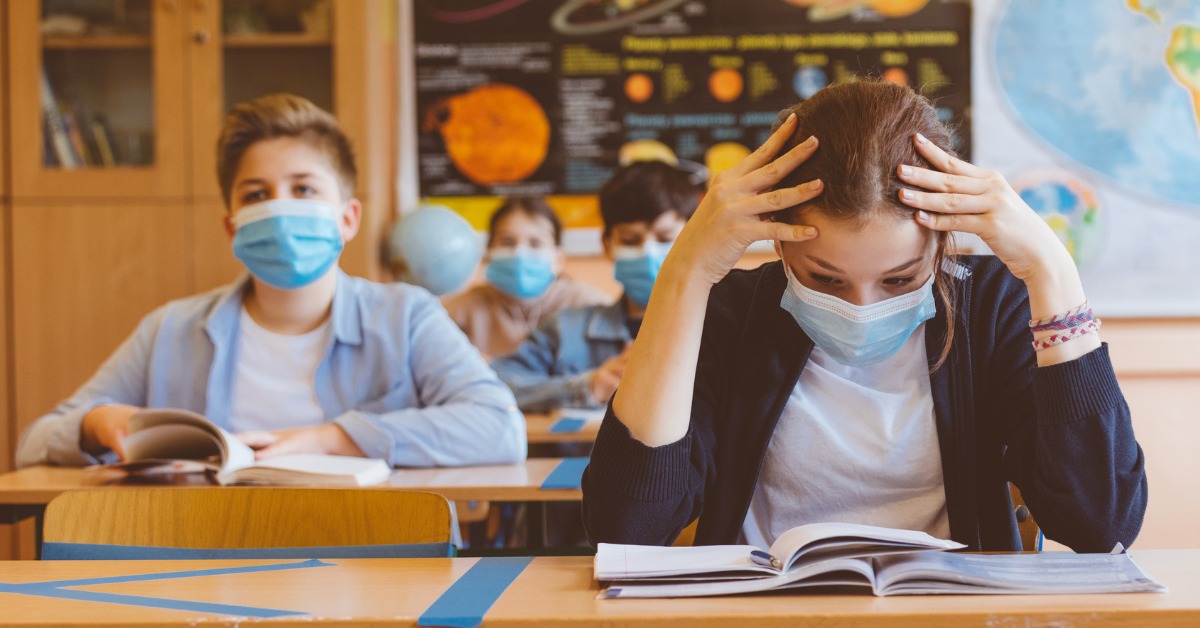
16 Aug Helping Children Cope: The Ongoing COVID Mental Health Crises In Schools
Children across the United States are heading back to school–many for the first time in over a year. Even before the COVID-19 pandemic, teachers were seeing more students with emotional trauma, depression, and anxiety. The New York Times, Los Angeles Times, and other publications have reported on the post-COVID mental health crisis in schools. Walk into any classroom, and you’ll find a vast number of students who have suffered from some sort of impact from the pandemic; from the loss of a loved one, to economic upheaval, isolation, and loneliness. It’s difficult for teachers to know the best coping strategies for student mental health crises even in the best of times. COVIDs impact continues to put new challenges into the classroom that go far beyond curriculum standards.
The Current Status of Mental Health in K-12 Schools
The news is not good: Mental Health America’s 2021 report found that 9.7% of young people in the United States under the age of 18 have severe major depression. In September 2020, over half of the children between the ages of 11-17 years who were surveyed by Mental Health America (MHA) reported having thoughts of self-harm or suicide — and more than two-thirds were LGBTQ+ youth.
Parents, too, may be struggling. The MHA’s screening program found that anxiety, depression, and thoughts of self harm among adults were growing more severe and increasing faster than at any other time in the program’s history. Families are experiencing food uncertainty, income uncertainty, and continued fears over variants of the coronavirus.
Identifying Mental Health Crises in Students
Mental health crises can begin silently in both children and adults. However, there are some signs that a crisis could be underway. They include:
- Self or substance abuse
- Abuse of others (bullying, anger)
- Difficulty performing daily living activities (bathing, dressing in clean clothing, brushing teeth and/or hair)
- Agitation and acting out
- Isolation
- Rapid mood swings
Severe crises can include a loss of touch with reality and extreme paranoia. Sadness, depression, and anxiety are all trauma responses following a loss or health crisis. The pandemic provided many factors that could bring on a student’s mental health crisis.
How Teachers Can Help
Teachers are not mental health professionals and shouldn’t be expected to do the job of one. But they can help offer a supportive, trauma-informed classroom that can help students build resilience and improve their physical and mental health. This mental health toolkit from Maryville University provides a good guide for teachers and classrooms.
Creating a trauma-informed classroom that helps students develop resilience can always create a sense of belonging that prevents crises. Trauma-informed classrooms are part of a positive and safe school environment.
Just providing a safe place where students can focus on their own learning and positive behaviors will help, and it’s the kind of help teachers are trained and qualified to provide as a K-12 educator. Teachers can model kind, supportive, and positive behaviors and decision-making just as they always have. It can’t hurt to be flexible and have a good sense of humor, either.
In a very serious situation, such as a student expressing thoughts of self-harm or suicide, contact professional help at your school as soon as possible. Many local schools and districts have dedicated mental health crisis response teams and health services teams that are trained to help.
Use creativity. Develop units and assignments that help students to work through their trauma and feelings through art, music, or other creative work. For example, ask students to create and write a postcard to someone or something (including COVID) that they are feeling angry or frustrated with.
The Most Important Coping Skill: Self-care
If teachers are overwhelmed, anxious, and struggling in the classrooms, students will immediately sense this, and the entire classroom can be thrown into turmoil. In order to help students cope with their anxiety, depression, and trauma, teachers need to be emotionally healthy and able to model positive behaviors and coping skills. They should take as much time as they’re able to exercise self care by doing things they enjoy outside of the classroom. From yoga to massages, caring for your body and spirit can recharge your own resiliency and coping skills.
Take some time to review videos or literature about trauma and mental health crises among students in the appropriate grade and age level. Continue to gain cultural fluency and responsiveness: students from varying cultures and their families will have different trauma responses. They may also have different beliefs about mental health treatment or healthcare in general. Gaining competency in different areas will strengthen you as well as your classroom.
The pandemic has been hard on everyone, and its impacts extend far beyond those who tragically fell ill and lost their lives. Educators are a vital part in helping students develop resilience and heal from trauma.



Sorry, the comment form is closed at this time.